



본 연구의 목적은 국내의 대표적인 침엽수인 소나무, 잣나무, 낙엽송, 분비나무로부터 추출된 정유의 제초활성을 이해하는데 있었다. 소나무, 잣나무, 낙엽송, 분비나무 정유의 기내 종자발아 제초활성 검정 결과, 유채에 대한 GR50 값은 각각 0, 4,766, 1,865, 5,934 μg ml-1으로 소나무를 제외하고는 제초활성을 나타내었다. 온실조건에서 소나무, 잣나무, 낙엽송, 분비나무 정유 10%를 5종의 화본과 잡초와 5종의 광엽잡초에 처리한 결과 도꼬마리를 제외하고는 24시간 내에 완전 고사되었으며, 처리 식물의 부위는 타는 듯한 화염상 증상을 나타내었고, 처리 3일 이후에는 신초가 재생하여 4종 식물 정유는 속효성, 비선택성, 비이행성 특성을 나타내었다. 소나무, 잣나무, 낙엽송, 분비나무의 정유를 GC-MS로 분석한 결과 각각 16종, 25종, 25종, 16종의 유기화합물이 검출되었으며, 이들 정유에는 탄화수소, 알코올, 케톤, 에스테르가 공통적으로 함유되어 있었다. 그리고 정유 4종의 주 화합물은 3-carene, bornyl acetate, camphene, limonene, α-pinene, β-pinene, β-phellandrene 이었다.
The objective of this research was to understand herbicidal activity of essential oils isolated from leaves of pine (
국내 산림면적은 총 6,368,843 ha로 그 중 침엽수는 41.8%로 가장 넓게 분포하고 있으며, 활엽수와 혼효림은 각각 29.9%와 30.3%를 차지하고 있다(Korea Forest Research Institute, 2011). 국내에 서식하고 있는 4과 10속 30종의 침엽수(Kong, 2004) 중 소나무, 잣나무, 분비나무, 낙엽송은 1960년대 이래 장기수 용재림 조성을 위하여 많이 식재되어 전국의 산에서 쉽게 발견되는데, 정부에서는 산림을 효과적으로 관리하기 위하여 가지치기 등의 숲가꾸기 사업을 하고 있으며 이를 통해 발생되는 폐산림자원은 바이오매스를 위한 자원으로 활용되고 있으나 부가가치는 매우 낮은 편이다.
식물 정유(essential oil)는 의료용품, 가정용품, 보안용품, 환경 및 위생용품, 공업용품, 사료용품 뿐만 아니라 농업용품으로의 활용이 가능하여(Batish et al., 2008) 산림자원의 부가가치를 높일 수 있다. 예를 들어 침엽수에 함유되어 있는 정유는 항염증성, 살균성, 식욕증진, 건위강장성, 순환촉진성, 탈취성, 거담성, 살충성, 신경안전성 등의 생물학적인 특성을 가지고 있는 것으로 보고되어 있어서(Mishra and Dubey, 1994) 의약품 개발에 활용이 가능하며, 진달래(
제초활성 식물의 정유는(Salamci et al., 2007) 농업용품 특히 제초제를 대용할 수 있는 친환경 농업자재로 개발이 가능할 뿐만 아니라 정유에 함유되어 있는 성분들은 신규 제초제 개발을 위한 좋은 모화합물이 될 수 있다는 제안이 이루어진 바 있다. 예를 들어 긴병꽃풀 정유(Kim et al., 2008)와 카쥬풋 정유(Lee et al., 2010)는 다양한 광엽잡초와 화본과잡초를 방제하는 것으로 보고되었고, 식물 정유에 함유되어 있는 1,4-cineole은 광엽잡초와 화본과잡초를 방제하는 제초제인 cinmethyline으로 개발된 바가 있다.
제초활성 식물로부터 정유를 얻고 상용화를 위해서는 시기별, 기후변화에 따른 정유함량의 변화와 같은 변수도 중요하지만(Batish et al., 2007) 무엇보다도 재료의 대량확보가 필요하며 이를 위한 가장 유망한 재료가 산림자원이라고 판단된다. 본 연구는 우리나라 산림자원 중 쉽게 대량으로 구할 수 있는 소나무, 잣나무, 분비나무, 낙엽송으로부터 정유를 확보하고, 정유의 살초활성을 검정하였으며, 정유에 함유되어 있는 화합물 분석을 수행하였다.
본 연구에서 사용된 소나무(
식물시료로부터 정유추출은 Choi et al. (2008)의 방법에 따라 수증기증류법으로 추출하였다. 수증기증류장치(Hanil LabTech, Korea)의 수증기 발생부위에 증류수 5 L, 시료적재 부위에 소나무, 잣나무, 분비나무, 낙엽송 시료 각각2 kg씩을 넣은 다음 냉각관에는 4°C의 냉각수가 지속적으로 흐르도록 하였다. 수증기 발생부위의 온도를 100°C로 1시간 유지시키면서 발생된 수증기가 식물시료가 담겨 있는 시료적재부위를 통과하며 정유가 추출되도록 하였다. 추출된 정유는 냉각관에서 응축된 후 정유포집기에 포집되었으며, 무수황산나트륨(anhydrous sodium sulfate)이 담겨있는 삼각깔데기를 통과시켜 수분을 제거한 후 정유 함량을 측정하여 회수율을 구하였다. 각각의 식물로부터 얻은 정유는 4°C의 냉장고에 보관하면서 제초활성실험 및 정유성분분석에 사용하였다.
실내실험
각 well 당 모래 1 g씩 담겨있는 24-well tissue culture test plate에 유채(
온실실험
국내 대표 침엽수 4종으로부터 추출된 정유의 경엽처리 제초효과를 검정하기 위하여 온실조건에서 실험을 수행하였다. 원예용 상토((주)부농)가 충진되어 있는 사각 플라스틱 포트(350 cm2)에 화본과잡초 5종{미국개기장(
정유성분의 기기분석
국내 대표 침엽수 4종 정유의 화학성분을 구명하기 위하여 침엽수 4종의 정유를 gas chromatography-mass spectrometry (GC-MS)로 분석하였다. GC 분석조건은 50°C에서 5분간 유지하고, 분당 4°C씩 250°C까지 승온시킨 후 10분간 유지하였으며, 운반기체는 헬륨(He)을 사용하였고, 유속은 1 ml min-1 이었다.
화학성분의 분석에 사용한 GC는 HP-5MS fused-silica capillary column (30 m×0.32 mm, 0.25 m)이 장착되어 있는 Agilent 7890A이었으며, MS는 5975C MSD이었다. MS의 분석조건은 ionization voltage가 70 eV, 이온소스온도는 280°C이었고, splitless mode를 사용하였다. GC와 MS의 분석조건은 Table 1에 나타내었으며, MS의 결과 성분분석은 Wiley 275와 NIST library의 mass spectrum data를 이용하여 확인하였다.
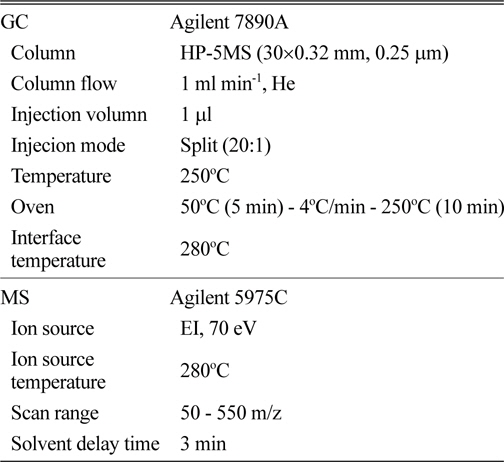
Analytical conditions of GC/MS for organic chemicals in the essential oil from pine, nut pine, larch and khingan fir.
우리나라에 서식하고 있는 침엽수종 중 많이 서식하고 있어서 향후 친환경자재로서 정유를 가장 많이 확보할 수 있는 것으로 소나무, 잣나무, 낙엽송, 분비나무를 선정하였다(Personal Communication Dr. Sangsup Han at Chonbuk National University). 강원대학교 학술림에서 2012년 9월에 식물을 채집하였고, 강원대학교 유기억 교수로부터 소나무, 잣나무, 낙엽송, 분비나무의 식물분류번호를 각각 KWNU 77488, 77259, 71082, 75961로 부여 받았다.
채집된 소나무, 잣나무, 낙엽송, 분비나무의 정유 함량은 각각 0.12, 0.20, 0.06, 0.17%이었다(Table 2). 본 연구의 결과 잣나무의 정유함량은 Kim et al. (2008)이 보고한 국내 향료식물 긴병꽃풀(
[Table 2.] Yield of pine, nut pine, larch and khingan fir essential oils
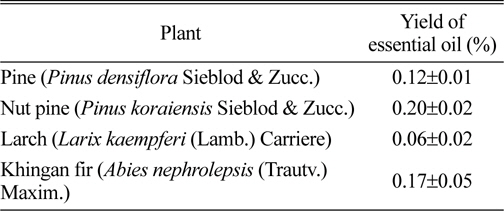
Yield of pine, nut pine, larch and khingan fir essential oils
식물정유 4종의 제초효과를 알아보기 위하여 24-well tissue culture test plates에서 유채(
[Table 3.] Growth inhibition activity of essential oils from pine, nut pine, larch and khingan fir.
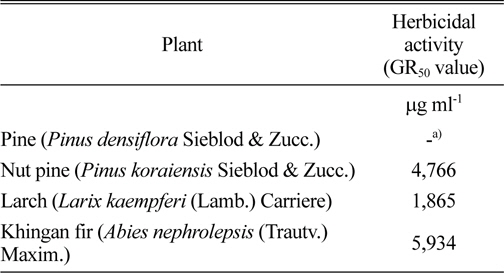
Growth inhibition activity of essential oils from pine, nut pine, larch and khingan fir.
식물 4종 정유의 제초활성을 온실에서 검정하기 위하여 화본과잡초 5종(미국개기장, 바랭이, 수수, 돌피, 개밀)과 광엽잡초 5종(까마중, 자귀풀, 어저귀, 도꼬마리, 메꽃)을 대상으로 실험을 수행하였다. 식물정유 1%를 경엽에 처리시 제초효과는 전혀 나타나지 않았으며, 5% 처리시 몇몇 초종에서 제초효과가 발현되었는데 특히 바랭이와 수 수는 대단히 민감하게 반응한 것으로 나타났다(Table 4). 식물정유 10% 경엽처리 시 도꼬마리를 제외한 모든 식물들이 고사되었는데, 처리 12시간 후부터 약효가 발현되기 시작하여 24시간 후에는 거의 모든 식물의 잎이 타는 듯한 화염상(burn-down) 증상을 나타내었고, 3일 후에는 최고 높은 제초활성을 보였다가 이후에는 재생되는 것으로 나타났다. 특히 미국개기장은 종자의 특성상 토양 표면 위로 늦게 출현되었기 때문에 검정일에는 기 고사된 개체 이외에 새롭게 지상부로 출현한 개체를 확인할 수 있었다. 많은 연구자들에 의해 식물정유의 특성이 속효성, 비선택성, 비이행성이라는 것이 보고되었는데(Bainard and Isman, 2006; Kim et al., 2008; Tworkoski, 2002; Yun et al., 2012) 본 연구에서도 동일한 결과를 보여주고 있다.
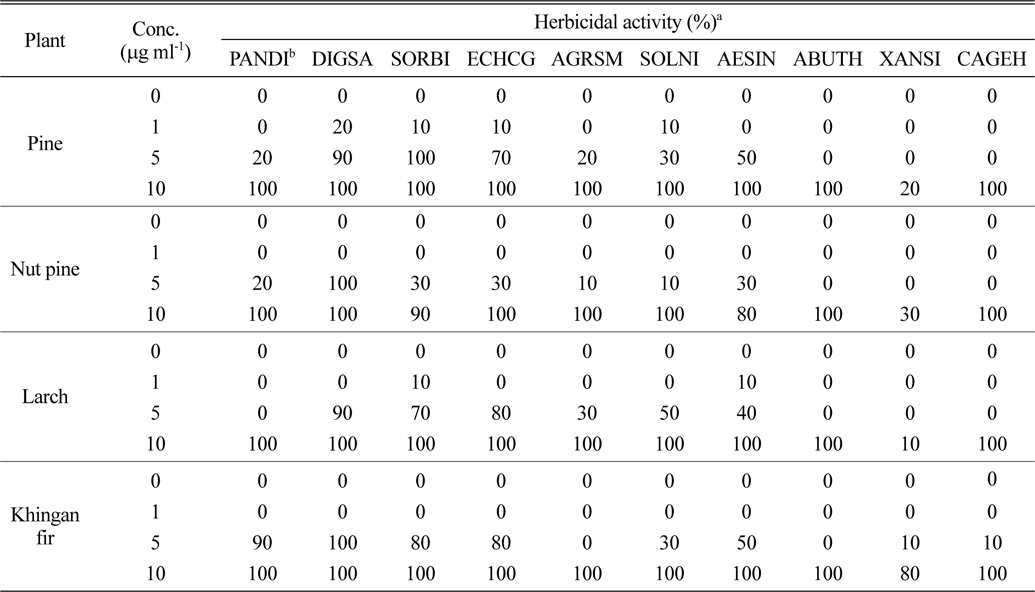
Herbicidal activity of pine, nut pine, larch and Khingan fir essential oils with post-emergence treatment on 10 weed species in a greenhouse.
본 연구에서 식물정유(10%) 처리로 모든 식물이 고사되었음에도 불구하고, 도꼬마리는 그 약해가 미약하였는데 그 이유로는 정유처리 시기에 도꼬마리의 생육상태가 다른 식물보다도 훨씬 좋았거나 혹은 도꼬마리 잎 표면 구조가 정유의 흡수를 저해하였을 것이라 추론되었다.
소나무 정유에 함유된 유기화합물을 GC-MS로 분석한 결과 총 16종의 화합물이 검출되었는데(Table 5) 소나무 정유에 함유된 화합물들을 화학구조 별로 분류하면 탄화수소류(hydrocarbons) 13종, 알코올(alcohol) 1종, 케톤(ketone) 1종, 그리고 에스테르(ester) 1종이었으며, 화학구조 별 함량은 탄화수소류가 87.50%, 에스테르가 10.6%, 케톤이 1.61%, 그리고 알코올이 0.33% 순이었다. 소나무 정유에 함유된 주된 화합물로는 α-pinene (24.69%), β-phellandrene (22.21%), β-pinene (20.55%), bornyl acetate(10.56%), camphene (5.47%), (+)-4-carene (3.14%), longifolene (2.72%), caryophyllene (2.43%) 등 이었다(Table 5).
[Table 5.] Chemical composition of pine essential oil.
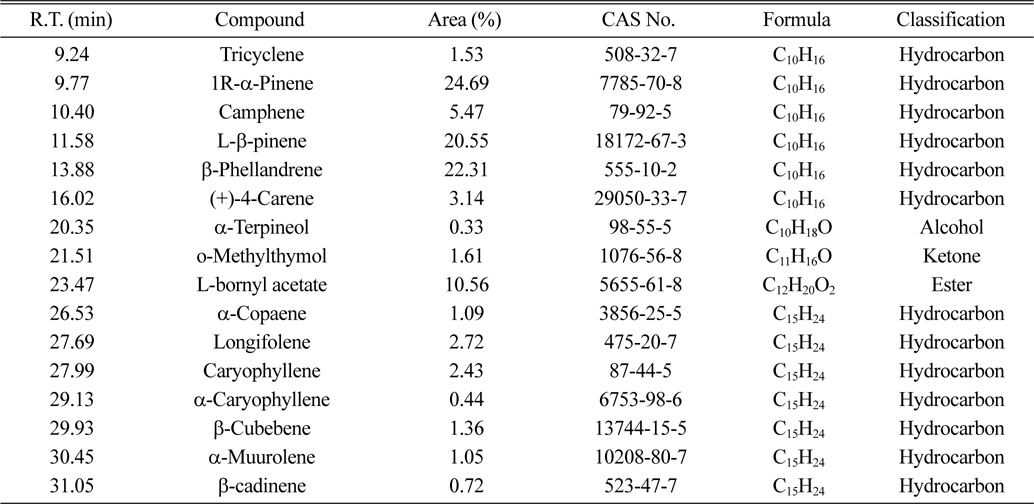
Chemical composition of pine essential oil.
잣나무 정유에 함유되어 있는 유기화합물을 GC-MS로 분석한 결과는 Table 6에 나타내었다. 잣나무 정유에는 총25종의 화합물이 검출되었는데 탄화수소류 20종, 알코올류 2종, 케톤류 2종, 그리고 에스테르 1종이 함유되어 있었다. 잣나무 정유에 함유된 화합물의 화학구조 별 함량은 탄화수소류가 89.21%, 알코올류가 0.67%, 케톤류가 0.64%, 그리고 에스테르가 9.47%이었으며, 주된 화합물은 α-pinene(33.22%), limonene (11.54%), camphene (10.10%), bornyl acetate (9.47%), (+)-4-carene (9.48%), β-pinene (8.99%), caryophyllene (2.65%), longifolene (2.59%)등 이었다(Table 6).
[Table 6.] Chemical composition of nut pine essential oil.
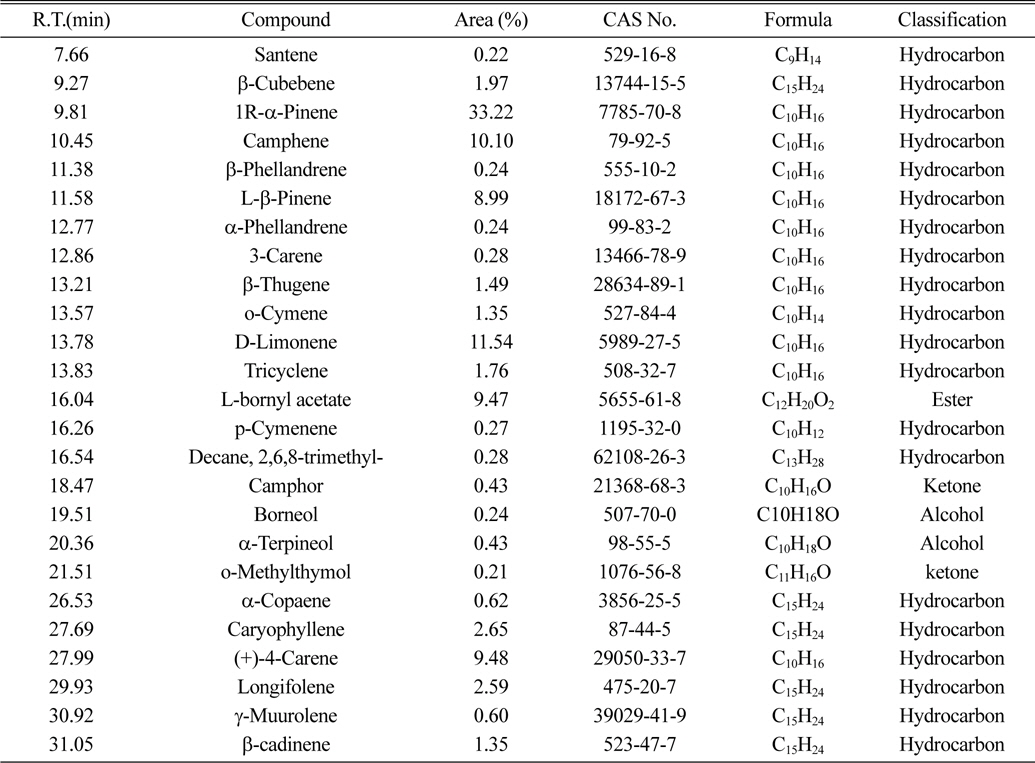
Chemical composition of nut pine essential oil.
낙엽송 정유에 함유되어 있는 유기화합물을 구명하기 위하여 GC-MS로 정유를 분석한 결과 총 25종의 화합물이 검출되었다(Table 7). 낙엽송 정유에서 검출된 유기화합물로는 탄화수소류 20종, 알코올류 2종, 케톤류 2종, 그리고 에스테르 1종을 들 수 있으며, 정유에 함유된 주된 화합물로는 α-pinene (19.86%), β-pinene (17.35%), bornyl acetate (15.29%), limonene (7.56%), β-pellandrene (7.38%), camphenex (5.20%), α-farnesene (4.95%), 3-carene (3.37%)등 이었다 (Table 7).
[Table 7.] Chemical composition of larch essential oil.
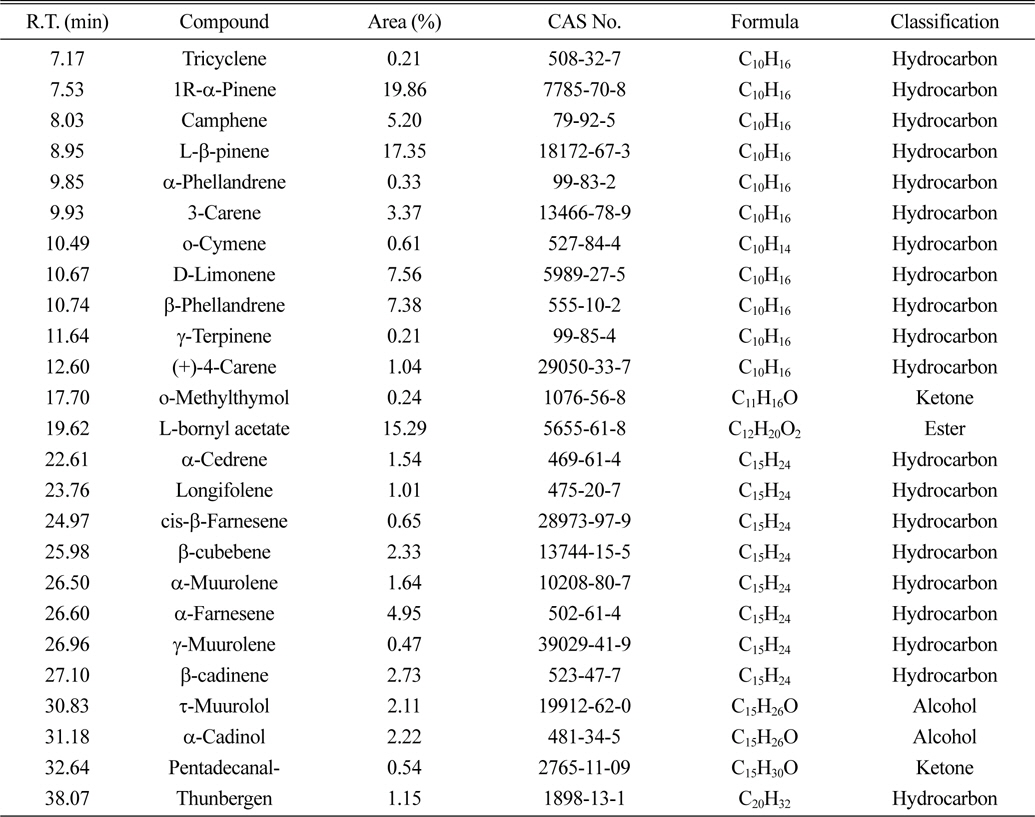
Chemical composition of larch essential oil.
분비나무 정유에는 총 16종의 유기화합물이 검출되었으며 탄화수소류 12종, 케톤류 2종, 알코올과 에스테르가 각각 1종씩 검출되었다(Table 8). 분비나무 정유에 함유된 화합물의 화학구조 별 함량은 탄화수소류가 85.59%, 에스테르가 12.54%, 케톤류가 1.23%, 그리고 알코올류가 0.64%이었으며, 정유에 함유된 주된 화합물로는 3-carene (21.52%),α-pinene (18.23%), β-pinene (14.98%), camphene (14.28%),bornyl acetate (12.54%), limonene (7.99%)등 이었다(Table 8).
[Table 8.] Chemical composition of Khingan fir essential oil.
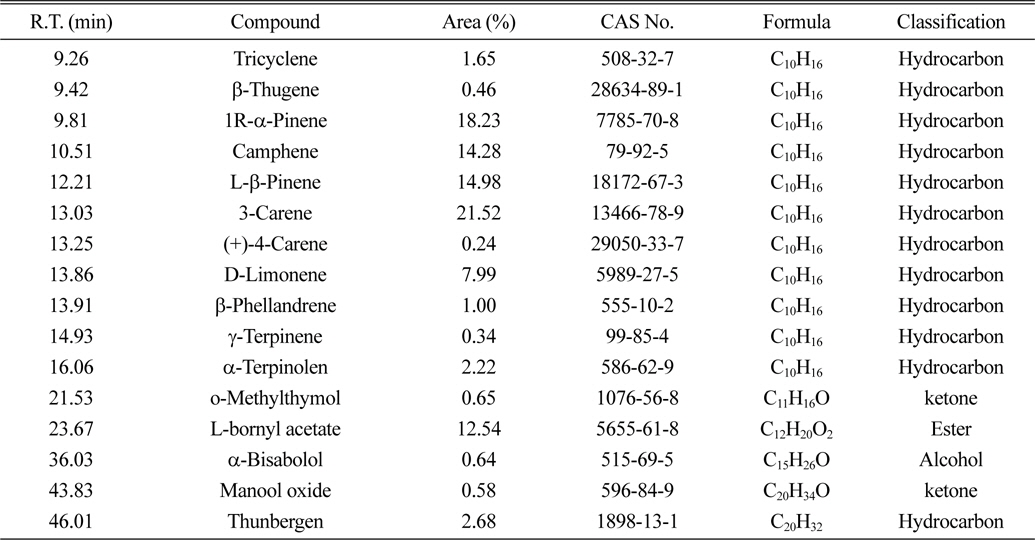
Chemical composition of Khingan fir essential oil.
본 연구에서 사용된 4종 침엽수의 정유는 실내실험과 온실실험을 통해 제초활성이 검정되었으며, 4종 정유에는 공통적으로 3-carene, bornyl acetate, camphene, limonene,α-pinene, β-pinene, β-phellandrene이 주 화합물로 함유되어 있었다. 이들 공통 화합물이 정유의 제초활성에 기여 했을 것이라 추론되지만 현재까지 각 화합물의 살초활성에 대한 연구 결과가 보고되어 있지 않기 때문에 얼마만큼 또 어떻게 기여했는지에 대해서는 알 수 없다.
본 연구를 통하여 잡초 유식물의 생장을 억제하는 활성을 나타낸 소나무, 잣나무, 낙엽송, 분비나무 정유는 잡초종합 방제 프로그램(Integrated Weed Management Program)에서 화학제초제를 대신하는 bioherbicide로 활용될 수 있을 것이라 판단된다(Dudai et al., 1999). 선행연구(Yun et al., 2012)에서 제안한 바와 같이 소나무, 잣나무, 낙엽송, 분비나무 정유는 국내 경작자들이 일부 비선택성 제초제를 헛골에 발생한 잡초를 방제하는 것처럼 비산방지캡을 장착하여 사용할 경우 비선택적으로 잡초를 방제하는데 활용할 수 있을 것이라 판단된다.







